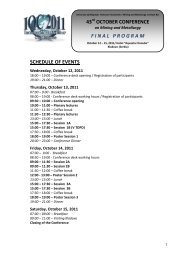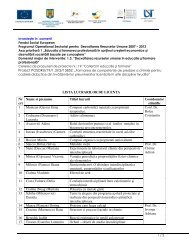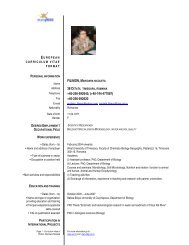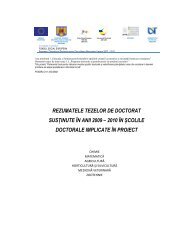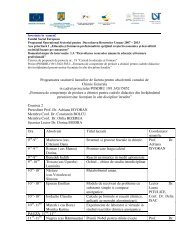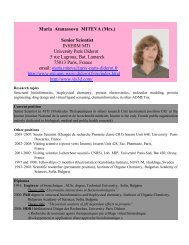Download PDF
Download PDF
Download PDF
You also want an ePaper? Increase the reach of your titles
YUMPU automatically turns print PDFs into web optimized ePapers that Google loves.
Annals of West University of Timisoara<br />
Series of Chemistry 18 (1) (2009) 73-80<br />
THE UTILIZATION OF AQUEOUS PEG(1550) -<br />
NANO3 TWO-PHASE SYSTEM FOR THE EFFICIENT<br />
EXTRACTION OF PB(II) WITH IODIDE<br />
EXTRACTANTS *<br />
SUMMARY<br />
Laura BULGARIU a , D. Bulgariu b,c*<br />
a Technical University Gheorghe Asachi of Iasi, Faculty of Chemical Engineering and<br />
Environmental Protection, Department of Environmental Engineering and<br />
Management, D. Mangeron, 71A, Iasi, 700050, ROMANIA<br />
b<br />
University ”Al. I. Cuza” of Iasi, Faculty of Geography and Geology, Department of<br />
Geology and Geochemistry, Bd. Carol I, 20A, 700506, Iasi, ROMANIA<br />
c<br />
Romanian Academy, Filial of Iasi, Collective of Geography, Bd. Carol I, 18A,<br />
700506, Iasi, ROMANIA<br />
The extraction of Pb(II) ions was studied in aqueous PEG(1550) - NaNO3 twophase<br />
systems, in absence and in presence of iodide extractants. The influence of several<br />
experimental parameters: initial Pb(II) concentration, salt stock solution pH and iodide<br />
ions concentration added in extraction systems was also investigated, in order to establish<br />
the optimum conditions of extraction process. The experimental results have show that in<br />
absence of suitable extracting agent, the Pb(II) extraction percent is low (< 15 %), and<br />
the variation of salt stock solution pH does not change too much the extraction efficiency.<br />
The addition of iodide ions determined a quantitative partition of Pb(II) into PEG-rich<br />
phase. The Pb(II) extraction efficiency is very little affected on the acidity of salt stock<br />
solution, but depends on the iodide concentration added in extraction system. On the basis<br />
of experimental results it can be stated that the extraction process of Pb(II) with iodide<br />
extractants, in considered aqueous two-phase system, involve successive elementary<br />
equilibriums, strictly dependent by the experimental conditions.<br />
Keywords: Pb(II); iodide extractants; extraction; aqueous two-phase system<br />
* This paper was presented at “Academic Days” Conference, XI edition<br />
Timişoara, 28-29 May 2009<br />
73
INTRODUCTION<br />
74<br />
B ULGARIU L., B ULGARIU D.<br />
The presence of Pb(II) in the environment has been serious concern, especially<br />
with the rapid industrialization, which created new uses for lead. The acute toxicity of lead<br />
to aquatic life and humans, and the stringent effluent standard to be met by industries as<br />
specified regulatory organizations has necessitated the development of innovative and<br />
economical methods for treating of lead-bearing waste waters [1].<br />
The aqueous two-phase systems have recently been showed to be a clean and<br />
economical alternative to the traditional extraction systems in industrial separation as well<br />
as environmental remediation applications [2, 3]. Aqueous two-phase systems, are formed<br />
when a water-soluble organic polymer (ex. polyethylene glycol, PEG) is mixed with certain<br />
inorganic salt (such as: Na2SO4, (NH4)2SO4, Na2CO3, NaNO3, K2HPO4), in specific<br />
concentration. Such aqueous two-phase systems are composed by two immiscible aqueous<br />
phases: a superior one - rich in PEG, which has the same role as organic phases from<br />
traditional extraction systems, and an inferior one - rich in inorganic salt.<br />
Beside, some evident advantages, like low toxicity, low flammability and low<br />
volatility, resulted by the fact that the organic solvents are not required for to prepare these<br />
extraction systems, another important one is that the quantitative extraction of metal ions<br />
can be obtained by using inexpensive water-soluble extracting agents, as halide or pseudohalide<br />
ions [3-6]. Thus, the utilization of aqueous two-phase systems for the extraction of<br />
metal ions, make that the risk of environmental contamination to be relatively low.<br />
The extraction of metal ions in aqueous two-phase systems mainly depend on the<br />
two factors: (i) the characteristics of aqueous two-phase systems, determined by the nature<br />
and concentration of inorganic salt and by molecular mass and concentration of PEG, and<br />
(ii) the stability and hydration degree of metallic species formed in extraction system [7-9].<br />
If the optimum characteristics of aqueous two-phase systems (stability, clear interface, time<br />
for phases separation, etc.) can be obtained by suitable selection of phase-forming<br />
components (PEG and inorganic salt, the second factor required the utilization of adequate<br />
extracting agent.<br />
According to studies from literature [10-15], in aqueous PEG-based two-phase<br />
systems some toxic metal ions (Hg(II), Cd(II), Bi(III), Cu(II), etc.) can be quantitatively<br />
extracted into PEG-rich phase using halide or pseudo-halide ions as extracting agents. It has<br />
also showed that the values of extraction percents are higher with the stability of metallic<br />
species formed in extraction system is higher, and the number of extractants associated with<br />
the metal ion depends on the acidity of salt stock solution [16, 17].<br />
In this study, the extraction of Pb(II) ions was studied in aqueous PEG(1550) -<br />
NaNO3 two-phase system, in absence and in presence of iodide extractants. The influence of
AQUEOUS PEG(1550) - NANO3 TWO-PHASE SYSTEM<br />
several experimental parameters: initial Pb(II) concentration, salt stock solution pH, iodide<br />
ions concentration added in extraction system, was also investigated in order to establish the<br />
optimum conditions of extraction process. The experimental results show that the Pb(II)<br />
extraction efficiency is very little affected on the acidity of salt stock solution, but depends on<br />
the iodide concentration added in extraction system. It can be also stated that the extraction of<br />
Pb(II) using iodide extractants, in considered aqueous two-phase system, occurs by successive<br />
elementary equilibriums, strictly dependent by the experimental conditions.<br />
MATERIALS AND METHODS<br />
Polyethylene glycol, PEG(1550), was purchased from Serva Feimbiochema Gmb<br />
& Co and was used as received. The inorganic salts: NaNO3 and NaI (from Aldrich) were<br />
reagents of analytical degree and were used without further purifications. The 40 % (w/w)<br />
of PEG(1550) and NaNO3 aqueous stock solutions were prepared by dissolving an<br />
appropriate mass of solid chemicals in twice distilled water. The different pH values (1.15,<br />
2.50, 4.65 and 7.05) of NaNO3 stock solution were obtained by adding small volumes of<br />
HNO3 concentrated solution (Reactivul Bucharest), which was considered in the total<br />
solution mass. The stock solution of 2000 µg Pb(II)/ml (∼ 0.01 mol/l) was prepared by the<br />
dissolving of lead nitrate (from Reactivul Bucharest) in twice distilled water, followed by<br />
the solution standardization [18]. The extracting agent solution (1 mol/l NaI) was obtained<br />
by dissolving halide salt and diluting to known volume with salt stock solution.<br />
For each experiment an aqueous two-phase system was prepared by mixing equal<br />
volumes of PEG(1550) stock solution and NaNO3 stock solution, with different pH, in a glass<br />
centrifuge tube. The pH values of NaNO3 stock solution was measured with a Radelkis OK-<br />
271 pH/ion-meter, equipped with a combined glass electrode. Then 0.3 ml of Pb(II) stock<br />
solution and (0.1 - 0.7 ml) of 1 mol/l NaI solution were added. The phases were disengaged by<br />
10 min of centrifugation at 2000 rpm and were carefully separated. Equal volumes from each<br />
phase were measured for the spectrophotometric analysis of Pb(II) with Arsenazo III. The<br />
Pb(II) concentration was determined in duplicate (Digital Spectrophotometer S 104 D, 1-cm<br />
glass cell, λ = 600 nm) [19], using a prepared calibration graph.<br />
The Pb(II) extraction efficiency was evaluated using experimental extraction<br />
percent values (E %), calculated with the relation:<br />
where: is the distribution coefficient, defined as the ratio of Pb(II) concentration in the<br />
PEG-rich phase to that in the salt-rich phase, and v is the volume ratio of the salt-rich phase<br />
and PEG-rich phase.<br />
(1)<br />
75
RESULTS AND DISCUSSIONS<br />
76<br />
B ULGARIU L., B ULGARIU D.<br />
In general terms, the formation of aqueous PEG-based two-phase systems is<br />
determined by the competition for hydration between PEG and inorganic salt [20, 21]. The<br />
addition of inorganic salt increase the dehydration degree of polymer chains, due to its<br />
salting-out effect, and in consequence the separation of the two phases occurs. This is the<br />
main reason for which at the preparation of aqueous two-phase systems inorganic salts with<br />
high and negative hydration free Gibbs energy, such as Na2SO4 or (NH4)2SO4, are<br />
preferred.<br />
Unfortunately in case of Pb(II) extraction, such inorganic salts are not adequate. In<br />
presence of sulphate ions, the precipitation of Pb(II) in the salt-rich phase occurs, according<br />
with the reaction:<br />
Pb 2+ + SO4 2- � PbSO4<br />
(2)<br />
and this will increase the time of extraction process and will decrease its efficiency [22].<br />
On the basis of these considerations, the NaNO3 was chose as inorganic salt for the<br />
preparation of aqueous two-phase system, and the concentration of phase-forming<br />
components (PEG and NaNO3) was selected that the system to remain two-phases<br />
throughout all experiments [23].<br />
In absence of iodide ions, Pb(II) remains predominantly in the lower, salt-rich<br />
phase, and the variation of salt stock solution pH not improve too much the extraction<br />
efficiency. The experimental value of Pb(II) extraction percent in function of salt stock<br />
solution pH are given in Table I.<br />
Table I. The Pb(II) extraction percent values obtained in absence<br />
of iodide in considered aqueous two-phase system<br />
pH 1.15 2.50 4.65 7.05<br />
E, % 14.43 11.62 10.02 6.96<br />
This is means that the extraction does not occur by chemical interactions between<br />
Pb(II) ions and donor of PEG from PEG- rich phase. The lower E % values can by<br />
explained by the high negative hydration free Gibbs energy of Pb(II) (ΔGhydr. = -1760 kJ/<br />
mol) [24], which make that Pb(II) to be incompatible with the low hydrated environment of<br />
PEG-rich phase of aqueous two-phase system. Under these conditions, for to increase the<br />
extraction efficiency the Pb(II) ions must be transformed into stable and low hydrated<br />
species, using suitable extracting agent.<br />
The use of iodide ions as inorganic extracting agent was investigated by following<br />
the Pb(II) extraction efficiency as a function of several experimental parameters: initial
AQUEOUS PEG(1550) - NANO3 TWO-PHASE SYSTEM<br />
lead(II) concentration, salt stock solution pH and iodide concentration added in extraction<br />
system.<br />
The influence of initial lead(II) concentration was studied over the range 20 - 65 μg<br />
Pb(II) /ml (Figure. 1). As shown in Figure 1, the Pb(II) extracted into the PEG-rich phase at<br />
constant iodide concentration (0.07 mol/l) increases with increasing initial metal ion<br />
concentration.<br />
[Pb(II)]- PEG-rich phase, µg/ml<br />
60<br />
50<br />
40<br />
30<br />
20<br />
10<br />
20 30 40 50 60 70<br />
Initial lead(II) concentration, µg/ml<br />
Figure 1. The effect of initial<br />
lead(II) concentration on<br />
extraction in presence of<br />
iodide ions (0.07 mol/l), salt<br />
stock solution pH = 4.65,<br />
temperature 19 °C<br />
On the basis of these observations and taking into account the limits of the<br />
spectrophotometric method used for Pb(II) analysis, an initial concentration of 63.7 μg<br />
Pb(II)/ml was selected for the further distribution studies.<br />
Within the pH range 1-7, the phase forming components (PEG, Na+, NO3-) are<br />
essentially uninvolved in secondary processes [23], indicating that stock salt solution pH<br />
has little effect on phase formation and separation.<br />
Experimental results (Figure 2) show that Pb(II) extraction efficiency is very little<br />
affected by variation in stock salt solution pH; the extraction percentages are high (92- 98<br />
%) for all pH values.<br />
E, %<br />
120<br />
110<br />
100<br />
90<br />
80<br />
70<br />
60<br />
0 2 4<br />
Salt stock solution pH<br />
6 8<br />
Figure 2. The effect of salt<br />
stock solution pH on Pb(II)<br />
extraction in the presence of<br />
iodide ions (0.07 mol/l). The<br />
initial Pb(II) concentration was<br />
63.7 µg/ml, temperature=19°C<br />
77
78<br />
B ULGARIU L., B ULGARIU D.<br />
In general, a decrease of salt stock solution pH, increases the PEG-rich phase<br />
hydrophobicity and enhances metal ion extraction [21]. However, for Pb(II) extraction, in<br />
considered aqueous two-phase system this tendency is not evident due to the high stability<br />
of the lead-iodide species formed in extraction system. Thus, the extraction efficiency does<br />
not increase in systems with higher acidity. In addition, the high Pb(II) extraction efficiency<br />
at pH = 7.05 suggests that the protonation of PEG ether oxygen atoms is not necessary.<br />
The use of iodide ions as inorganic extracting agent was investigated by studying<br />
the extraction of Pb(II) as function of NaI concentration added in extraction system. A<br />
comparison for all four media studied is given in Figure 3.<br />
It can be observed from Figure 3 that in these systems Pb(II) is quantitatively<br />
extracted for all four pH values. Maximum extraction occurs at lower iodide concentration<br />
when the acidity is high. Thus, at pH = 1.15 and 2.05, the maximum extraction is obtained<br />
at 0.04 mol iodide/l; for pH=4.65, the iodide necessary is 0.05 mol/l; and for the systems<br />
with pH=7.05 it is higher yet (0.06 mol/l). This behaviour is attributed to the increased<br />
PEG-rich phase hydrophobicity with decreased pH, which suggests that equilibriums<br />
forming lead-iodide species are involved.<br />
On the basis of these experimental observations, we can assume that the extraction<br />
process of lead(II) with iodide, in considered aqueous two-phase system, involve a<br />
succession of elementary equilibriums, which are strict dependent by the experimental<br />
conditions (Figure 4).<br />
E, %<br />
100<br />
80<br />
60<br />
40<br />
20<br />
0<br />
pH=1.15<br />
pH=2.50<br />
pH=4.65<br />
pH=7.05<br />
0 0.02 0.04<br />
NaI, mol/l<br />
0.06 0. 08<br />
Figure 3. The dependence of<br />
Pb(II) extraction percent on<br />
the NaI concentration added<br />
in extraction system. The<br />
initial Pb(II) concentration was<br />
63.7 µg/ml, temperature=19°C<br />
In considered aqueous two-phase system, the anionic species formed at the<br />
interface cross into the PEG-rich phase, where they will interact, predominantly by ionic<br />
forces, with PEG ether oxygen atoms. Electroneutrality of the two aqueous phases is<br />
ensured by ionic transfer. Thus, during extraction of Pb(II) anionic complexes, the nitrate<br />
ions which accompanied phase separation are expelled into the salt-rich phase and the<br />
phases are kept electrically neutral.
AQUEOUS PEG(1550) - NANO3 TWO-PHASE SYSTEM<br />
Figure 4. Schematic representation of elementary equilibriums involved in extraction process of Pb(II)<br />
with iodide, in aqueous PEG(1550) - NaNO3 two-phase system<br />
CONCLUSION<br />
The extraction of Pb(II) ions in aqueous PEG(1550) - NaNO3 two-phase systems<br />
was investigated as a function of initial lead(II) concentration, salt stock solution pH and<br />
iodide ions concentration added in extraction system.<br />
In absence of suitable extractants, the Pb(II) prefer to remain in the salt-rich phase<br />
of extraction system and a poor extraction was observed for all four studied pH values of<br />
salt stock solution.<br />
The addition of iodide ions in the 0.01 - 0.07 mol/l concentration range determined<br />
an enhancement of extraction efficiency, and Pb(II) is quantitatively extracted for all four<br />
pH values. Maximum extraction is obtained at lower iodide concentration when the acidity<br />
of salt stock solution is high. Thus, at pH = 1.15 and 2.05, the maximum extraction is<br />
obtained at 0.04 mol iodide/l; for pH=4.65, the iodide necessary is 0.05 mol/l; and for the<br />
systems with pH=7.05 it is higher yet (0.06 mol/l). This behaviour is attributed to the<br />
increased PEG-rich phase hydrophobicity with decreased pH, which suggests that<br />
equilibriums forming lead-iodide species are involved.<br />
On the basis of the experimental results, it can be stated that the extraction process<br />
of Pb(II) with iodide extractants, in considered aqueous two-phase system, involve a<br />
succession of elementary equilibriums, which are strictly dependent by the experimental<br />
conditions.<br />
ACKNOWLEDGEMENTS<br />
This research occurred by PNCDI 2 – D5 no. 51045-2007 for which the authors<br />
acknowledge financing authority.<br />
79
REFERENCES<br />
80<br />
B ULGARIU L., B ULGARIU D.<br />
1. Patterson J.W., "Industrial wastewater treatment technology", Butterworth Publishers, Stoneham, MA,<br />
USA, 1985.<br />
2. Visser A.E., Griffin S.T., Ingenito C.C., Hartman D.H., Huddleston J.G., Rogers R.D., "Aqueous biphasic<br />
systems as a novel environmentally benign separation technology for metal ion removal", Metal Sep.<br />
Technol. Beyond, (2000), 119-130.<br />
3. Rogers R.D., Bond A.H., Bauer C.B., "Polyethylene glycol-based aqueous biphasic system for liquid / liquid<br />
extraction of environmentally toxic heavy metal", Solv. Extr. in Proc. Ind., 3 (1993), 1641–1648.<br />
4. Rogers R.D., Bond A.H., Bauer C.D., "Metal Ion Separation in Aqueous Polyethylene Glycol-Based<br />
Aqueous Biphasic Systems", Sep. Sci.Technol., 28(5) (1993), 289-304.<br />
5. Shibukawa M., Nakayama N., Hayashi T., Shibuya D., Endo Y., Kawamura S., " Extraction behaviour of<br />
metal ions in aqueous polyethylene glycol – sodium sulphate systems in presence of iodide and<br />
thiocyanate ions", Anal. Chim. Acta, 427 (2001), 293-300.<br />
6. Graber T.A., Andrews B.A., Asenjo J.A., "Model for the partition of metal ions in aqueous two-phase<br />
system", J. Chromatogr. B, 743 (2000), 57-64.<br />
7. Zaslavski B.Y., Gulaeva N.D., Djafarov S., Masimov E.A., Miheeva L.M., " Phase Separation in Aqueous<br />
Poly(ethylene glycol)-Ammonium Sulphate Systems and Some Physicochemical Properties of the<br />
Phase", J. Coll. Interface Sci., 137 (1990), 147-156.<br />
8. Sibukawa M., Matsuura K., Shinozuka Y., Mizuni S., Oguma K., " Effects of Phase-Forming Cations and<br />
Anions on the Partition of Ionic Solutes in Aqueous Polyethylene Glycol – Inorganic Salt Two-Phase<br />
System”, Anal. Sci., 16 (2000), 1039-1044.<br />
9. Bulgariu D., Bulgariu L., Pui A., "The extraction and the determination of cadmium from geological<br />
samples (I)", Anal. Univ. „Al.I.Cuza” Iaşi, s. Geologie, XLIX-L (2004), 31-44.<br />
10. Bulgariu L., Bulgariu D., "Extraction of metal ions in aqueous PEG-inorganic salt two phase systems in<br />
presence of inorganic extractants Correlation between extraction behaviour and stability constants of<br />
extracted species", J. Chromatogr. A, 1196-1197 (2008), 117-124.<br />
11. Bulgariu L., Bulgariu D., "Cd(II) extraction in PEG (1550)–(NH4)2SO4 aqueous two-phase systems using<br />
halide extractants", J. Serb. Chem. Soc., 73(3) (2008), 341-350.<br />
12. Bulgariu L., Bulgariu D., "The Hg(II) Extraction in PEG-Based Aqueous Two-Phase System In Presence of<br />
Halide Ions. I. The Liquid Phases Analysis", Central Europ. J. Chem., 4(2) 2006, 256-257.<br />
13. Bulgariu L., Bulgariu D., Sarghie I., Malutan T., " Cd(II) extraction in PEG-based aqueous two-phase<br />
systems in the presence of iodide ions. Analysis of PEG-rich solid phases", Central Europ. J. Chem., 5(1)<br />
2007, 291-302.<br />
14. Bulgariu L., Bulgariu D., "The influence of phase-forming salt on Cd(II) extraction in aqueous PEG-based<br />
two-phase systems", Rev. Roum. Chim., 53(2) (2008), 141-147.<br />
15. Rodriguesa G.D., Carmo Hespanhol da Silva M., da Silva L.H.M., Paggiolia F.J., Minimb L.A., Sélia dos<br />
Reis Coimbra J., "Liquid-liquid extraction of metal ions without use of organic solvents", Sep. Purific. Sci.<br />
Technol., 62(3) (2008), 687-693.<br />
16. Bulgariu L., Sarghie I., "The extraction of Cd(II) in polyethylene glycol-based aqueous two-phase system<br />
in presence of iodide ions. I. The preliminary results", Anal. Univ. “Al. I. Cuza” Iasi, s. chemistry, XIII<br />
(2005), 27–34.<br />
17. Bulgariu L. Bulgariu D., "The Zn(II) extraction in PEG-based aqueous two-phase systems using<br />
thiocyanate ions as extracting agents", Bull. I.P.Iasi, s. chemistry, 1-2 (2007), 25-32.<br />
18. Dean J.A., "Handbook of Analytical Chemistry", McGraw-Hill Inc., New York, 1995.<br />
19. Flaschka A.H., Barnard A.J., "Chelates in Analytical Chemistry", Marcel Dekker Inc., New York, 1967.<br />
20. Ananthapadmanabhan K. P., Goddar E.D., "Aqueous Biphasic Formation in Polyethylene Oxide –<br />
Inorganic Salt Systems", Langmuir, 3 (1987), 25-31.<br />
21. Rogers R.D., Bond A.H., Bauer C.B., Zhang J., Griffin S.T., " Metal ion separation in polyethylene glycolbased<br />
aqueous biphasic systems: correlation of partition behaviour with available thermodynamic<br />
hydration data", J. Chromatogr. B, 680 (1996), 618-621.<br />
22. Bulgariu L., Bulgariu D., "Lead(II) extraction in aqueous PEG(1550) - (NH4)2SO4 two-phase system using<br />
iodide ions as extracting agents", Bull. I.P.Iasi, (in press).<br />
23. Graber T.A., Taboada M.E., " Liquid-Liquid Equilibrium of the Poly(ethylene glycol) + Sodium Nitrate +<br />
Water System at 298.15K", J. Chem. Eng. Data, 45 (2000), 182-184.<br />
24. Marcus Y., " Thermodynamics of Solvation of Ions ", J. Chem. Soc. Faraday Trans., 87(18) (1991), 2995–2999




